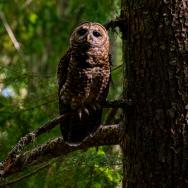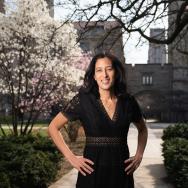If a tree falls in the forest, and only artificial intelligence is listening, is a data point recorded? Such questions have become pertinent to a collaborative research project by scientists from the University of Chicago, Argonne National Laboratory and the University of Wisconsin–Madison.
The research team is deploying autonomous recording equipment in natural areas—including the Morton Arboretum—to eavesdrop on the animals. Doing so can help answer important scientific questions, such as which species are present and how their abundance changes over time.
Their long-term goal is to characterize natural soundscapes using artificial intelligence, and to use that data as a baseline to measure how ecosystems are responding to climate change and other human-induced changes.
“The new field of bioacoustics allows us to study biodiversity at a very large scale,” said Rajesh Sankaran, an experimental systems specialist at Argonne who co-leads the project. “By placing a few microphones in a forest, you can get exposure to a lot of different organisms occupying that forest without needing to detect them during fieldwork.”
For decades, the only way for scientists to track long-term trends in animal populations over large areas was via time-intensive monitoring: Biologists would trek out into the field, take notes on what they saw, and return year after year. Then they would have to spend hundreds of hours processing data back in their labs to identify trends.
Such data have yielded important insights: For example, projects such as the Breeding Bird Survey and the annual Christmas Bird Counts conducted by thousands of volunteers have helped scientists determine that North America has lost a quarter of its bird population—three billion birds—in the last 50 years.
But passive acoustic biodiversity monitoring offers even bigger possibilities, according to Sankaran, thanks to technological advances that have allowed for far more efficient data processing and storage.
Sankaran works in the field of “edge computing,” a computing architecture that allows some data to be processed instantaneously, as it is recorded and stored. So, a recorder strapped to a tree could theoretically take advantage of this technology by filtering out abiotic (non-animal) sounds—like a clap of thunder, wind rustling leaves or a falling tree—and storing only those that researchers are interested in, like a warbler singing once a minute, or a katydid chirping.
This both reduces the amount of time scientists have to spend combing through data afterward and saves huge amounts of storage space on the machines so they can record more hours of data uninterrupted.
From silence springs data
By listening to the animals that are present, the scientists can also make inferences about those that are not present, according to Asst. Prof. Eyal Frank, an environmental economist at the Harris School of Public Policy at UChicago who is also a co-lead on the project.
In a healthy ecosystem, Frank explained, most of the acoustic space is typically occupied by one animal or another.
“Think of radio stations,” Frank said. “We have a regulatory agency that says who can broadcast on what frequency, or channel. Over evolutionary timescales, the same thing happens in nature: Species adapt to one acoustic niche to communicate with each other … and a vibrant, flourishing ecosystem will have no gaps. Every frequency will have someone speaking on it.”
But as soon as we start losing species, Frank said, we start seeing gaps. That means that as habitats change—perhaps because of climate change, the arrival of a new invasive species, or human development—determining which species are going missing and why can contribute insights that are important for reducing biodiversity loss.
“In a selectively logged forest, we might see a really big difference in that index of just how ‘empty’ or ‘full’ the forest is,” Frank added. “What edge computing allows us to do is pare down what would be gigabytes or even petabytes of data to just the metric that we’re interested in: The ‘saturation index.’”
The saturation index is a measure of the extent to which the acoustic space is occupied—essentially, whether silences on some frequencies indicate the absence of certain organisms. Think about a piano on which all the “C” keys were missing. If “Cs” corresponded to chipmunks, that ecosystem wouldn’t have any, and the “scale” would be incomplete.
Right now, the scientists are still testing their recording systems and data processing algorithms. They have planned to deploy some of the recorders in zoos—where they know all the species that are present—to test their model’s ability to recognize relevant sounds.
“Most of my work is focused on tropical forests, where our lab records the sounds of hundreds of species singing at the same time,” said Zuzana Burivalova, an assistant professor of forest and wildlife ecology at the University of Wisconsin–Madison who is also a collaborator on the project.
“But testing out new algorithms and equipment set ups in a local zoo or arboretum is a necessary step before carrying out advanced experiments in the rainforest. Things should work perfectly at home to ensure that they will work in remote locations.”
Once testing is complete, the possibilities for “natural experiments” are many, according to Sankaran and Frank, who imagine placing recorders in environments that range from fairly pristine to highly disturbed by human activity.
“We often think about massive disruptions to habitats like deforestation,” Frank said. “But we also know that subtler disturbances are important: A recent study showed that during COVID-19 lockdowns, some bird species vocalized differently in San Francisco in response to reductions in ambient noise.”
The project is funded in part by the Joint Task Force Initiative, a University of Chicago program designed to foster increased collaboration across disciplines and between the University, Argonne National Laboratory and Fermilab (Fermi National Accelerator Laboratory). Pete Beckman, a computing expert at Argonne, is also a collaborator on the project.
According to Frank, collaboration between social scientists like himself studying the impact of conservation policies and engineers, computer scientists and wildlife ecologists is key to the project’s success: “The combination of all these fields and disciplines and expertise is needed to be able to solve this massive challenge: A large gap in our understanding and quantification of biodiversity,” he said.

